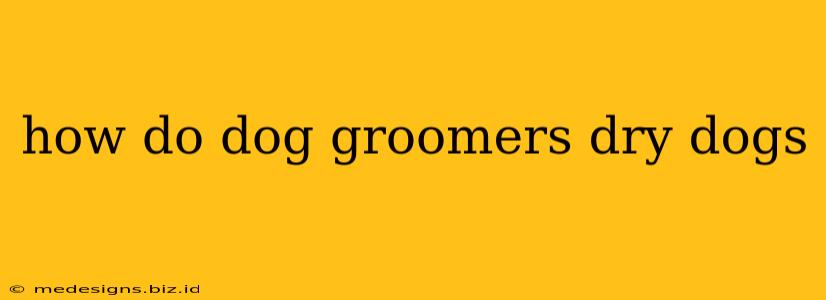Drying a dog after a bath is a crucial part of the grooming process, impacting both their coat health and overall comfort. Professional dog groomers use a variety of techniques to ensure a thorough and gentle drying experience. This guide dives into the methods employed, highlighting the pros and cons of each.
Understanding the Importance of Proper Drying
A wet dog is not just uncomfortable; it's also susceptible to hypothermia, especially in smaller breeds or those with thin coats. Moreover, leaving a dog damp can lead to skin irritation, bacterial growth, and a lingering unpleasant odor. Therefore, efficient and effective drying is paramount.
Common Dog Drying Methods Used by Groomers
Professional groomers employ a combination of techniques to achieve optimal results. Here are the most prevalent methods:
1. High-Velocity Force Dryers
These are the workhorses of most grooming salons. These powerful dryers, sometimes called "turbo dryers," use a high-velocity airflow to quickly remove surface water.
- Pros: Fast drying time, minimizes the risk of a dog getting cold, reduces the time needed for other grooming tasks.
- Cons: Can be noisy and intimidating for some dogs, requires careful handling to avoid blowing the dog's fur in unwanted directions.
2. Towel Drying
Before any other method, towel drying is always the first step. Groomers use absorbent towels to remove as much excess water as possible. This significantly reduces drying time with other methods.
- Pros: Gentle, readily available, helps to remove loose dirt and debris along with water.
- Cons: Can be time-consuming, particularly for large, thick-coated breeds, may not dry the coat completely.
3. Air Drying
Air drying is sometimes used in conjunction with other methods, especially for dogs with delicate or sensitive skin. It’s generally not a stand-alone method, though.
- Pros: Gentle and safe, ideal for dogs with sensitive skin or specific health conditions.
- Cons: Extremely time-consuming, not suitable for all breeds or weather conditions.
4. Grooming Gloves
These specialized gloves are often used in conjunction with towel drying for a more thorough and faster initial water removal.
Choosing the Right Drying Method
The best drying method depends on several factors:
- Dog Breed: Thick-coated breeds will require more time and potentially a combination of methods. Smaller dogs may need gentler techniques to avoid overheating.
- Coat Type: Curly or double-coated breeds benefit from careful drying to avoid matting.
- Dog's Temperament: Some dogs are more sensitive to the noise and airflow of high-velocity dryers, while others are quite tolerant.
Tips for Drying Your Dog at Home
While professional groomers have specialized equipment, you can still achieve good results at home. Follow these tips:
- Start with a thorough towel dry: Use several towels to soak up excess water.
- Use a pet-safe hairdryer: Keep the dryer on a low heat setting and hold it at a safe distance.
- Be patient and gentle: Don't rush the drying process, and avoid pointing the dryer directly at the dog's face.
- Consider a low-velocity dryer: These are less intense than high-velocity dryers, and more suitable for home use.
Conclusion:
Drying a dog properly is essential for their health and well-being. Professional groomers utilize a variety of techniques, tailoring their approach to the individual dog's needs. By understanding these methods, dog owners can better care for their canine companions.
